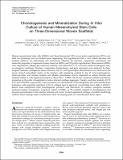Chondrogenesis and mineralization during in vitro culture of human stem cells on 3D-woven scaffolds
Author(s)
Abrahamsson, Christoffer K.; Yang, Fan; Park, Hyoungshin; Brunger, Jonathan M.; Valonen, Piia K.; Langer, Robert; Welter, Jean F.; Caplan, Arnold I.; Guilak, Farshid; Freed, Lisa E.; ... Show more Show less
DownloadAbrahamsson-2010-Chondrogenesis and m.pdf (401.3Kb)
PUBLISHER_POLICY
Publisher Policy
Article is made available in accordance with the publisher's policy and may be subject to US copyright law. Please refer to the publisher's site for terms of use.
Terms of use
Metadata
Show full item recordAbstract
Human mesenchymal stem cells (hMSCs) and three-dimensional (3D) woven poly(ɛ-caprolactone) (PCL) scaffolds are promising tools for skeletal tissue engineering. We hypothesized that in vitro culture duration and medium additives can individually and interactively influence the structure, composition, mechanical, and molecular properties of engineered tissues based on hMSCs and 3D poly(ɛ-caprolactone). Bone marrow hMSCs were suspended in collagen gel, seeded on scaffolds, and cultured for 1, 21, or 45 days under chondrogenic and/or osteogenic conditions. Structure, composition, biomechanics, and gene expression were analyzed. In chondrogenic medium, cartilaginous tissue formed by day 21, and hypertrophic mineralization was observed in the newly formed extracellular matrix at the interface with underlying scaffold by day 45. Glycosaminoglycan, hydroxyproline, and calcium contents, and alkaline phosphatase activity depended on culture duration and medium additives, with significant interactive effects (all p < 0.0001). The 45-day constructs exhibited mechanical properties on the order of magnitude of native articular cartilage (aggregate, Young's, and shear moduli of 0.15, 0.12, and 0.033 MPa, respectively). Gene expression was characteristic of chondrogenesis and endochondral bone formation, with sequential regulation of Sox-9, collagen type II, aggrecan, core binding factor alpha 1 (Cbfα1)/Runx2, bone sialoprotein, bone morphogenetic protein-2, and osteocalcin. In contrast, osteogenic medium produced limited osteogenesis. Long-term culture of hMSC on 3D scaffolds resulted in chondrogenesis and regional mineralization at the interface between soft, newly formed engineered cartilage, and stiffer underlying scaffold. These findings merit consideration when developing grafts for osteochondral defect repair.
Date issued
2010-07Department
Harvard University--MIT Division of Health Sciences and TechnologyJournal
Tissue Engineering. Part A
Publisher
Mary Ann Liebert, Inc.
Citation
Abrahamsson, Christoffer K. et al. “Chondrogenesis and Mineralization During In Vitro Culture of Human Mesenchymal Stem Cells on Three-Dimensional Woven Scaffolds.” Tissue Engineering Part A 16.12 (2011): 3709-3718. ©2010 Mary Ann Liebert, Inc.
Version: Final published version
ISSN
1937-3341
1937-335X